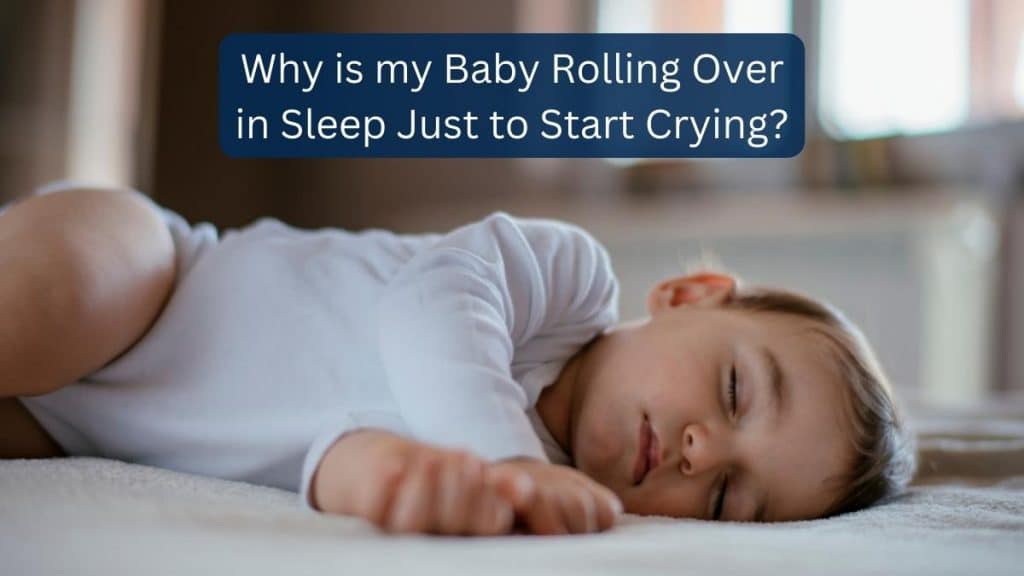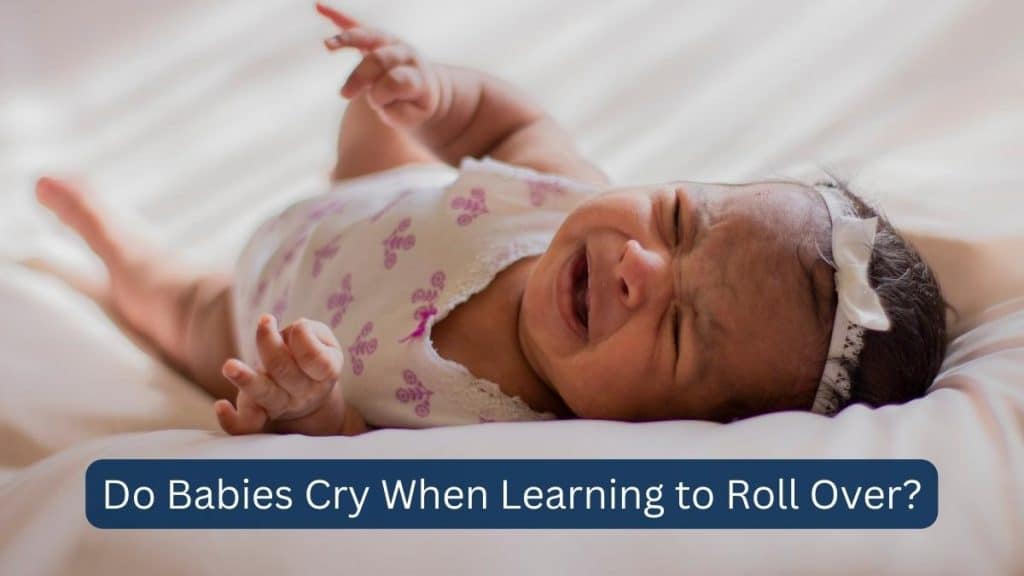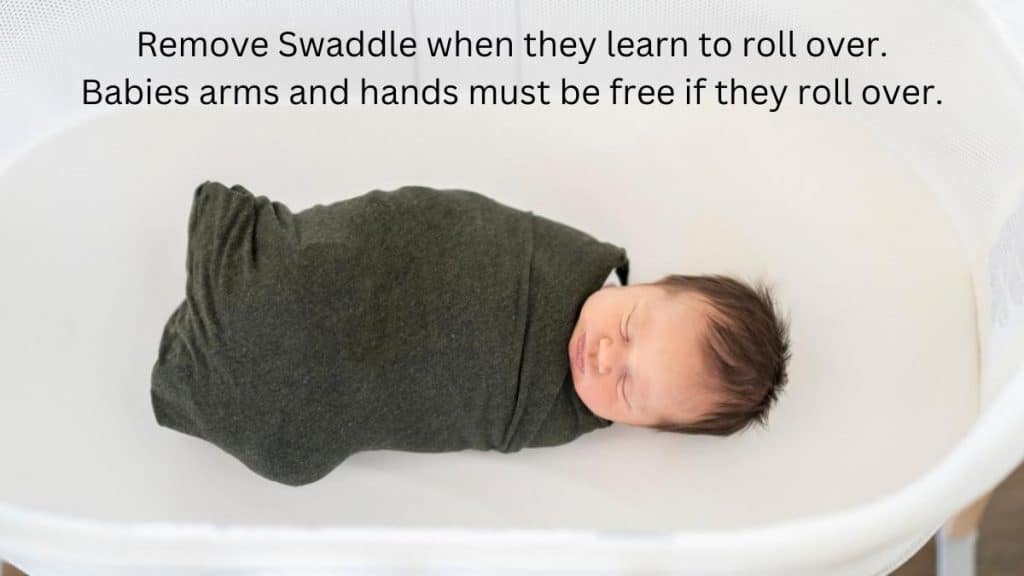Does your baby roll over when sleeping and start crying?
Rolling is a significant developmental milestone for infants and the precursor to crawling.
However, if an infant rolls over while sleeping in a swaddle, a parent or caregiver may need to alter their sleeping habits.
When a baby rolls over while they are asleep, it may hint that they will roll over on purpose when awake.
This article explains why babies begin to roll, why they roll over in sleep just to start crying, provides answers to some frequently asked questions regarding this stage of development, and offers advice on whether to consult a doctor.
Why is my Baby Rolling Over in Sleep Just to Start Crying?

Watching your small child grow, develop, and pick up new abilities must be very thrilling. Watching our infants learn to roll over is usually the first significant mobility milestone that makes parents squeal with delight.
I’m sure you get what I mean. When you first observe your infant arching her back, lifting her head, leaning to one side, and then – FLOP! She is reclining!
Adorable and fascinating!
Unless it occurs while you’re asleep. After all, that is frustrating and draining for most of us.
Why? Because a baby who is rolling and then starts crying is not sleeping (as I know you can attest). Your baby likely woke him or herself up from rolling in the sleep.
So how can you prevent your small baby from rolling over as he or she sleeps, keep him or her secure, and make sure he or she gets enough rest?
Do Babies Cry When Learning to Roll Over?
Although you cannot prevent your baby from rolling over at night, you may assist them in becoming accustomed to their new ability and returning to sleep.
Your baby may experience a slight sleep regression when they first start to roll over because they are more likely to wake up and cry when they do it. You can certainly comfort them in their room and put them back on their backs.

I know that you don’t want to play “flip the baby” all night. It may be time for a more formal response if your kid is rolling over during the night and waking up sobbing more than once, keeping everyone up all night.
Is it OK if The Baby Rolls Onto Their Stomach When Sleeping?
No. Until the baby turns one, please. Even if your baby rolls onto his or her stomach at night, you should still put him or her to bed on his or her back until 12 months old. Doing this significantly lowers your baby’s chance of SIDS, which is one of the most common causes of infant death, particularly in the first four to six months of life.
Additionally, encouraging back sleep is a good habit to develop. Back sleepers typically have a lower risk of fever, nasal congestion, and ear infections than stomach sleepers. Furthermore, they have the same risk of spitting up or choking on their spit as infants who sleep on their stomachs.
How do I Stop my Baby From Rolling Over at Night?
Following safe sleep recommendations is a top priority as an infant sleep consultant. We constantly advise our readers to adhere to the ABCs of safe sleeping.
Additionally, we want to support the growth and independence of your child! This calls for accepting the roll, even when your child turns over while sleeping and ends up face down in an unusual position for you.
The first time your kid flips onto their stomach while sleeping may be unsettling, especially in light of all the “back is best!” preaching.
Let’s discuss some crucial steps you may take to lessen the risk that your baby will suffer harm if they roll over while sleeping.
Ensure Safe Sleep Surfaces
You probably use safe sleep techniques if you’ve been following my recommendations since you first brought your child home.
Remember that your infant should sleep on a sturdy, level, and secure surface.
Don’t let your infant fall asleep in an inclined posture, especially once they begin rolling over (like an unbuckled car seat or a recalled Rock N Play).
Additionally, if your baby is in a bassinet and begins to roll over, it’s time to move them to a crib because they are now too big for the bassinet.
Say Goodbye to the Swaddle

You should take your baby out of the swaddle as soon as you notice them rolling for the first time. You need to remove your baby from the swaddle even if they start to turn over.
If your infant rolls onto their stomach while sleeping, their arms and hands must be free. They’ll need their arms free to roll back or lift and shift their head to the side to breathe.
To assist your baby in understanding that evening is approaching and as part of the bedtime routine, I adore utilizing sleep sacks. Swaddling your child can be changed into a sleep sack, which releases their arms.
Clear Bumpers And Bedding From the Sleep Area
Any soft objects in your baby’s crib, now that they can move around more readily, present a greater danger of suffocation.
Ensure your sleeping baby’s cot is free of bumpers or extra blankets. Your child’s crib shouldn’t contain any extraneous bedding. Wearable blankets are a great way to keep your baby warm at night.
Let The Baby Sleep on Their Back
Even when your baby can roll over, continue to put them to sleep on their back.
If your baby is determined to roll over, they will, and that’s OK. But until they are 12 months old, you should always lay them down on their back because it has been found to be the most secure sleeping posture for small infants.
A kid would flip over as soon as you put her in the crib. To assist lower the danger of SIDS, you should always make sure you lay him or her on their back.
Related Questions
Can Babies Suffocate From Rolling Over?
Parents and caregivers may be concerned that when babies start rolling over, whether awake or asleep, they will become stuck on their stomachs, increasing the danger of asphyxia. An infant can lift their head and breathe once they turn over onto their stomach.
Do Sleep Sacks Prevent Babies From Rolling Over?
Yes. Infants should always sleep in a sleep sack that allows their arms to be free and their hips and legs to move after they start to roll over since it is safe.
This guarantees their freedom of movement and ability to push themselves back up when they begin to roll over independently. Once they begin to turn over on their own, babies shouldn’t be using sleep sacks with swaddling attachments or wraps because they risk becoming trapped or suffocating.
To make sure their newborns are secure while they are sleeping, parents or other caretakers are highly advised to check on them from time to time.
